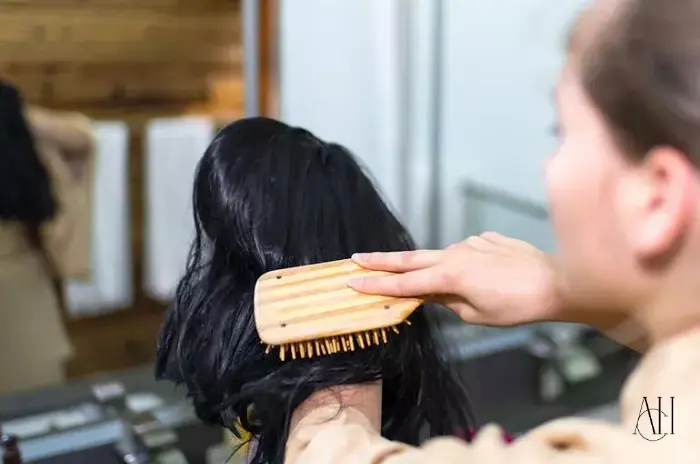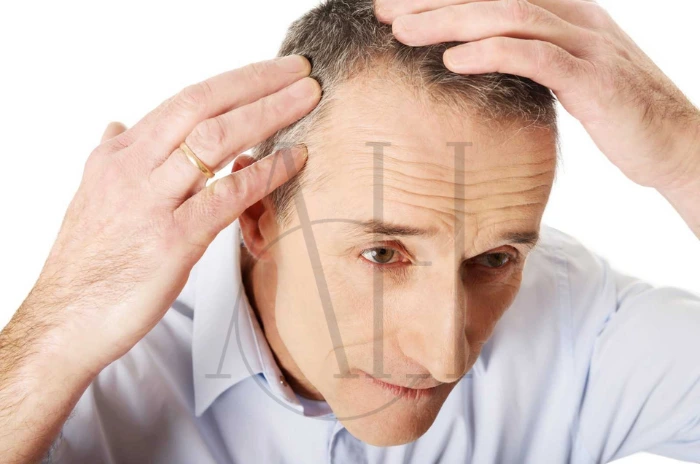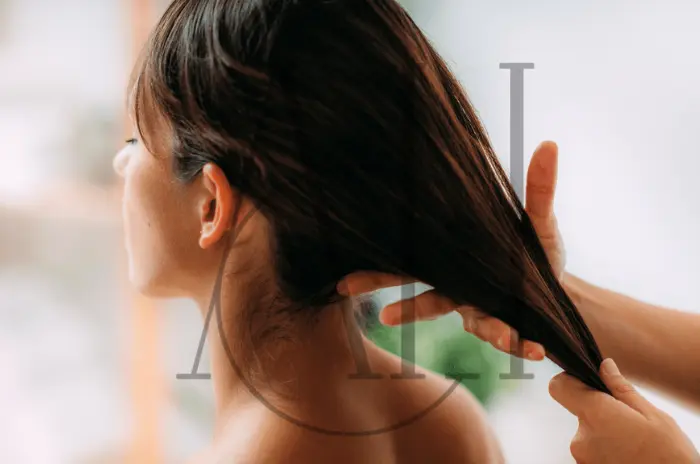Caring for your wig properly is essential for maintaining its appearance, longevity, and your confidence. Whether you’re new to wearing wigs or looking to improve your current routine, understanding the fundamentals of wig care can make all the difference. From washing techniques to styling tips, this comprehensive guide covers everything you need to know about keeping your wig looking beautiful and natural.
Table of Contents
ToggleWhat to Know About Wig Care
Understanding the basics of wig care is crucial for anyone who wants to maintain their investment and ensure their wig continues to look its best. Proper care not only extends the life of your wig but also keeps it looking natural and feeling comfortable throughout wear.
The Difference Between Human Hair and Synthetic Wigs
Human hair wigs and synthetic wigs require completely different care approaches. Human hair wigs behave like your natural hair, meaning they can be washed with regular shampoo, styled with heat tools, and even colored. These wigs typically last longer but require more maintenance and investment in quality hair care products.
Synthetic wigs, on the other hand, are made from artificial fibers that maintain their style even after washing. They’re more affordable and easier to care for, but they have limitations when it comes to heat styling. Most synthetic wigs will melt or become damaged when exposed to high temperatures from styling tools.
The choice between human hair and synthetic affects every aspect of your wig care routine, from washing frequency to styling options. Understanding your wig type is the first step in developing an effective care regimen.
Why Proper Care Extends Your Wig’s Life
Investing time in proper wig care can significantly extend your wig’s lifespan. A well-maintained human hair wig can last 12-18 months with regular wear, while a synthetic wig typically lasts 3-6 months. Without proper care, even the highest quality wigs can become tangled, matted, or lose their shape within weeks.
Regular maintenance prevents common issues like tangling, frizz, and premature wear. It also helps maintain the wig’s original style and color, ensuring you continue to look your best. The small investment in proper care products and techniques pays dividends in the long run.
Proper storage, gentle handling, and appropriate cleaning methods are the cornerstones of effective wig care. These practices help preserve the wig’s structure and appearance while preventing damage that could require costly repairs or early replacement.
How Often Should You Wash Your Wig?
The frequency of washing depends on your wig type and how often you wear it. Human hair wigs should be washed every 10-14 wears or approximately every 2-3 weeks with regular use. Washing too frequently can strip natural oils and cause premature wear.
Synthetic wigs require less frequent washing, typically every 15-20 wears or when they start to look dull or feel sticky. Over-washing synthetic wigs can cause the fibers to break down faster and lose their original style.
Signs that your wig needs washing include loss of shine, tangling, odor, or feeling heavy from product buildup. Environmental factors like humidity, pollution, and lifestyle activities may require more frequent washing. Always assess your wig’s condition rather than following a strict schedule.
Wig Styling Tips for a Natural Look
Achieving a natural appearance with your wig requires understanding the right styling techniques for your specific wig type. Whether you’re working with human hair or synthetic fibers, the key is using appropriate methods that enhance rather than damage your wig.
How to Curl or Straighten a Synthetic Wig
Synthetic wigs require special techniques for styling since they can’t withstand traditional heat styling tools. For curling, use foam rollers, pin curls, or the steam method. Wrap sections of hair around foam rollers while the wig is slightly damp, then allow it to air dry completely.
The steam method involves using hot water to create gentle curls. Dip the wrapped sections in hot (not boiling) water for a few seconds, then let them dry completely. This technique works best with heat-friendly synthetic fibers, but always test a small section first.
For straightening synthetic wigs, use a flat iron on the lowest heat setting (under 275°F) or try the wet-brush method. Gently brush the wig while it’s damp with a wide-tooth comb, then allow it to air dry while maintaining tension. Remember that most synthetic wigs return to their original style after washing.
Using Heat on Human Hair Wigs: Dos and Don’ts
Human hair wigs can handle heat styling tools just like natural hair, but they require extra protection since they don’t receive natural oils from the scalp. Always apply a heat protectant spray before using any heated styling tools to prevent damage and maintain moisture.
Keep heat settings moderate – use 300°F or lower for fine hair and up to 350°F for coarse hair. Higher temperatures can cause irreversible damage to the hair cuticles, leading to dryness, breakage, and loss of shine.
Avoid excessive heat styling, as human hair wigs are more susceptible to damage than your natural hair. Limit heat styling to 2-3 times per week and always allow the wig to cool completely before brushing or handling. Consider air-drying methods when possible to minimize heat exposure.
Easy Everyday Wig Styles for Beginners
Creating simple, natural-looking styles doesn’t require professional skills. Start with gentle finger-combing to separate and fluff the hair, then use light-hold styling products to maintain the look throughout the day.
For a sleek look, use a paddle brush and light serum to smooth down any flyaways. Part the hair where it looks most natural – this is usually where the wig is constructed to have a natural-looking part line.
Volume can be added by gently teasing the crown area with a fine-tooth comb or by using volumizing mousse at the roots. Always work from the bottom up and use gentle motions to avoid damaging the wig’s construction or creating tangles.
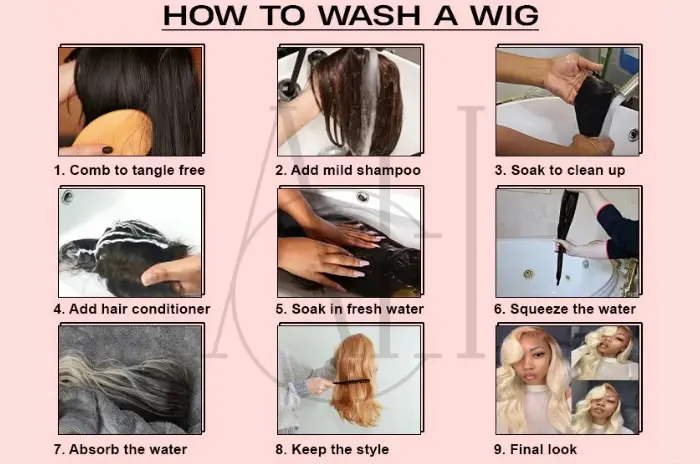
How to Wash a Wig the Right Way
Proper washing technique is fundamental to wig care and significantly impacts your wig’s longevity and appearance. The process differs between human hair and synthetic wigs, so understanding the correct method for your wig type is essential.
Steps to Shampoo and Rinse Your Wig
Begin by gently brushing your wig with a wide-tooth comb to remove tangles before washing. Fill a basin with cool water and add a small amount of wig-specific shampoo or sulfate-free shampoo for human hair wigs.
Submerge the wig in the water and gently swish it around for 2-3 minutes. Avoid rubbing or scrubbing motions that can cause tangling or damage to the wig’s construction. Focus on the cap area where oils and products tend to accumulate.
Rinse thoroughly with cool water, ensuring all shampoo is removed. Hold the wig by the cap, not the hair, and gently squeeze out excess water. Never wring or twist the wig, as this can cause permanent damage to the fibers or alter the wig’s shape.
Tips for Conditioning Your Wig Without Damage
Human hair wigs benefit from regular conditioning to maintain moisture and manageability. Apply conditioner from mid-length to ends, avoiding the cap area where it could loosen the hair attachments.
Leave the conditioner on for 3-5 minutes, then rinse thoroughly with cool water. For deep conditioning treatments, use a leave-in conditioner or hair mask once a month to restore moisture and shine.
Synthetic wigs don’t typically require conditioning, but if your synthetic wig feels dry or tangled, use a wig-specific conditioner sparingly. Apply only to the hair ends and rinse immediately to prevent buildup that could weigh down the synthetic fibers.
How to Dry a Wig Safely
Proper drying technique is crucial for maintaining your wig’s shape and preventing damage. After washing, gently squeeze out excess water using a clean towel – never rub or twist the hair.
Place the wig on a wig stand or mannequin head to air dry. This helps maintain the wig’s shape and allows air to circulate around the entire piece. Avoid placing the wig in direct sunlight or near heat sources, which can fade colors or damage fibers.
For human hair wigs, you can use a blow dryer on a low heat setting, but air drying is always the gentlest option. Synthetic wigs should never be blow-dried unless they’re specifically labeled as heat-friendly.
How to Dry a Wig Correctly
The drying process is one of the most critical aspects of wig care, as improper drying can lead to tangling, shape distortion, and premature wear. Each wig type requires specific drying techniques to maintain optimal condition.
Pat Dry with Towel, Don’t Brush While Wet
After washing, immediately but gently blot your wig with a clean, absorbent towel. Press the towel against sections of the wig to absorb moisture without rubbing or creating friction that could cause tangling.
Never brush or comb a wet wig, as the hair is most vulnerable to breakage when saturated with water. The weight of the water combined with brushing motion can stretch and damage both human hair and synthetic fibers.
If you must detangle, wait until the wig is slightly damp rather than soaking wet. Use a wide-tooth comb and work from the ends upward, supporting each section as you work to minimize stress on the wig’s construction.
Dry Synthetic Wigs on a Stand for Best Shape
Synthetic wigs maintain their style best when dried on a wig stand or styrofoam head. The stand supports the wig’s shape and allows proper air circulation, which is essential for synthetic fibers to return to their original style.
Position the wig stand in a well-ventilated area away from direct heat or sunlight. Synthetic fibers can be damaged by excessive heat, so room temperature air drying is always the safest option.
Allow 6-8 hours for complete drying, depending on the wig’s density and your environment’s humidity. Once dry, synthetic wigs typically bounce back to their original style with minimal manipulation required.
Blow-Dry Human Hair Wig, Style While Drying
Human hair wigs can be blow-dried using proper technique and heat protection. Apply a heat protectant spray and use a blow dryer on medium heat with a diffuser attachment to distribute heat evenly.
Style the wig while drying by using a round brush to create volume or smoothness, depending on your desired look. Work in small sections and keep the dryer moving to prevent overheating any one area.
Consider rough-drying the wig to about 80% dry, then finishing with styling tools on lower heat settings. This approach minimizes overall heat exposure while still allowing you to achieve your desired style.
When to Replace Your Wig
Knowing when to replace your wig is an important part of wig care that ensures you always look your best. While proper maintenance can extend a wig’s life, all wigs eventually reach the end of their useful lifespan.
Signs Your Wig is Worn Out
Several indicators signal that it’s time for a new wig. Excessive tangling that doesn’t improve with proper wig care is often the first sign of wear. If your wig tangles immediately after brushing or washing, the fibers may be damaged beyond repair.
Loss of shine and luster, even after proper cleaning and conditioning, indicates that the hair cuticles (in human hair wigs) or synthetic fibers have been compromised. Fading or color changes, particularly around the hairline and crown, are also signs of normal wear.
Thinning areas, particularly at the temples or crown, suggest that the wig’s construction is breaking down. If you notice bald spots or significantly reduced density in certain areas, it’s time to start shopping for a replacement.
How Long Do Human Hair Wigs Last?
With proper wig care, human hair wigs typically last 12-18 months with regular wear. Factors affecting longevity include the quality of the hair, frequency of wear, styling habits, and maintenance routine.
High-quality virgin human hair wigs can last even longer with exceptional care, sometimes up to two years. However, wigs made from processed or lower-grade hair may show signs of wear within 6-12 months.
The key to maximizing your human hair wig’s lifespan is consistent, gentle care. Regular deep conditioning, minimal heat styling, and proper storage can help you get the maximum value from your investment.
When It’s Time for a New Look
Sometimes replacing a wig isn’t about wear but about wanting a change. If you’ve been wearing the same style for months and feel ready for something new, this is a perfect opportunity to explore different colors, lengths, or styles.
Consider your lifestyle changes too. A wig that worked perfectly for one phase of your life might not suit your current needs. Perhaps you need something lower maintenance, or you’re ready to try a more dramatic style.
Color fading can also be an opportunity rather than a problem. If your wig has lightened or changed color over time, you might decide to embrace the new shade or use it as motivation to try something completely different.
Washing and Styling Your Wig
The combination of proper washing and styling techniques forms the foundation of effective wig care. Understanding how these processes work together helps you maintain your wig’s appearance while preventing damage.
Proper Washing Techniques for Real Hair Wigs
Human hair wigs require gentle washing techniques that preserve the hair’s integrity while removing buildup and oils. Start with lukewarm water, as hot water can strip moisture and cause color fading.
Use sulfate-free shampoos designed for chemically processed hair, as these are gentler on the hair cuticles. Apply shampoo primarily to the cap area where oils and products accumulate, and gently work the lather through the length of the hair.
Rinse thoroughly and follow with a moisturizing conditioner applied from mid-length to ends. Leave the conditioner on for 3-5 minutes before rinsing with cool water to seal the hair cuticles and enhance shine.
Recommended Washing Frequency
The ideal washing frequency for your wig depends on several factors including wear frequency, environmental conditions, and product use. Human hair wigs worn daily should be washed every 10-14 wears to prevent buildup while preserving natural moisture.
If you use styling products regularly or live in a humid or polluted environment, you may need to wash more frequently. Conversely, occasional wear or minimal product use allows for longer intervals between washes.
Synthetic wigs require less frequent washing, typically every 15-20 wears. These wigs don’t absorb oils like human hair, so over-washing can actually shorten their lifespan by breaking down the synthetic fibers.
The Importance of a Wig Block for Washing
Using a wig block or mannequin head during washing provides stability and helps maintain the wig’s shape. This tool is particularly important for human hair wigs that can lose their style when wet.
A wig block allows you to secure the wig during washing, preventing tangles and making the process more manageable. It also enables proper rinsing by allowing water to flow through the hair naturally.
For drying, a wig block maintains the wig’s circumference and helps it retain its original shape. This is especially important for wigs with specific cuts or styles that could be distorted if dried flat or improperly supported.
Gentle Styling and Heat Protection
Gentle styling techniques are essential for preserving your wig’s condition and extending its lifespan. Always start with clean, completely dry hair and use products specifically designed for wigs or chemically processed hair.
For human hair wigs, apply heat protectant before using any heated styling tools. Use the lowest effective temperature setting and avoid concentrating heat on any one area for extended periods.
Consider heatless styling methods like braiding damp hair for waves, using foam rollers, or trying pin curls. These techniques create beautiful styles without the potential damage associated with high-heat styling tools.
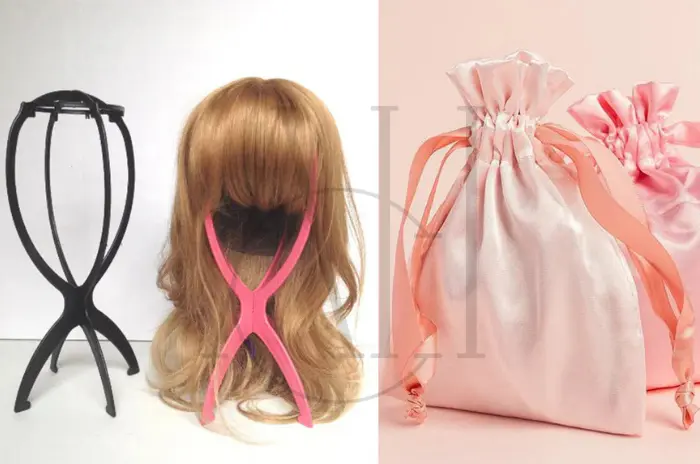
How to Store Your Wig Correctly
Proper storage is a crucial component of wig care that often gets overlooked. How you store your wig when not wearing it significantly impacts its longevity, shape retention, and overall condition.
Should You Use a Wig Stand or Silk Bag?
The choice between a wig stand and silk bag depends on your storage needs and available space. Wig stands are ideal for daily wear wigs as they maintain the wig’s shape, allow air circulation, and keep the style intact between wears.
A wig stand is particularly beneficial for synthetic wigs that rely on maintaining their manufactured shape. The stand prevents flattening and helps the wig retain its volume and style without additional manipulation.
Silk bags are better for long-term storage or travel. Silk’s smooth surface prevents tangling and reduces friction that could cause breakage. However, wigs stored in bags should be placed on a stand periodically to maintain their shape.
Tips for Long-Term Wig Storage
When storing a wig for extended periods, proper preparation is essential. Clean the wig thoroughly and ensure it’s completely dry before storage to prevent mold, mildew, or odor development.
Store wigs in a cool, dry place away from direct sunlight, which can fade colors and weaken fibers. Avoid areas with temperature fluctuations like attics or basements, as these conditions can damage both human hair and synthetic materials.
For human hair wigs, apply a light leave-in conditioner before storage to maintain moisture. Synthetic wigs should be stored clean and product-free to prevent buildup that could attract dirt or cause stiffness.
How to Prevent Tangling and Dust Buildup
Preventing tangling starts with proper brushing before storage. Use a wide-tooth comb or wig brush to gently remove all tangles, working from the ends toward the roots to minimize stress on the hair.
Cover stored wigs with a hair net or silk scarf to protect against dust accumulation. Dust not only makes wigs look dull but can also cause irritation when worn and may require more frequent washing.
Check stored wigs monthly, giving them a gentle shake and light brushing if needed. This prevents minor tangles from becoming major problems and helps you identify any issues early.
How Often to Wash and Maintain Your Wig
Establishing a proper maintenance schedule is fundamental to effective wig care. The frequency of washing and maintenance activities varies significantly between wig types and individual usage patterns.
Wash Human Hair Wigs Every ~Three Weeks—Less Often Than Natural Hair
Human hair wigs don’t produce natural oils like your scalp does, so they require less frequent washing than your natural hair. Washing every 10-14 wears or approximately every three weeks is typically sufficient for maintaining cleanliness without over-processing.
This reduced washing frequency helps preserve the hair’s moisture and prevents premature dryness and breakage. Human hair wigs that are over-washed can become brittle and lose their natural luster more quickly.
Monitor your wig’s condition rather than following a strict schedule. Factors like climate, activity level, and product use may require adjustments to your washing frequency. The goal is to maintain cleanliness while preserving the hair’s integrity.
Natural Drying Helps Synthetic Wigs Regain Their Original Style
Synthetic wigs have a unique advantage in that they’re designed to return to their original style after washing and air drying. This “memory” feature makes maintenance easier but requires proper drying techniques to work effectively.
Air drying on a wig stand allows synthetic fibers to relax back into their manufactured shape without manipulation. This process typically takes 6-8 hours but results in a wig that looks freshly styled with minimal effort.
Avoid brushing or styling synthetic wigs while they’re drying, as this can interfere with their ability to regain their original shape. Once completely dry, a gentle shake or light finger-combing is usually all that’s needed to restore the style.
Additional Recommendations
Comprehensive wig care extends beyond basic washing and styling to include specialized considerations for different users and situations. These additional recommendations help address common concerns and optimize the wig-wearing experience.
Focus on Gentle, Non-Irritating Techniques
Sensitivity is a key consideration in wig care, particularly for individuals experiencing hair loss due to medical treatments. Use fragrance-free, hypoallergenic products whenever possible to minimize the risk of scalp irritation.
Choose soft-bristled brushes and wide-tooth combs that won’t scratch or irritate sensitive skin. When washing, use lukewarm rather than hot water, and avoid vigorous scrubbing motions that could cause discomfort.
Pay attention to the wig cap material and construction. Look for caps with soft, breathable linings and minimal seams that could cause pressure points or irritation during extended wear.
Include Product Recommendations for Sensitive Skin
Select wig care products specifically formulated for sensitive skin or those used during medical treatments. Sulfate-free shampoos, alcohol-free styling products, and fragrance-free conditioners are gentler options.
Consider using baby shampoo for ultra-sensitive skin, as these formulations are designed to be mild and non-irritating. Always patch-test new products on a small area before full application.
Look for products containing soothing ingredients like aloe vera, chamomile, or oat extracts that can help calm and protect sensitive scalp skin while maintaining effective wig care.
Address Common Treatment-Related Concerns
Individuals undergoing medical treatments may face unique wig care challenges. Chemotherapy and radiation can affect scalp sensitivity, making gentle care techniques even more important.
Temperature regulation becomes crucial during treatment, so choose breathable wig cap materials and avoid heavy styling products that could increase discomfort. Lightweight, well-ventilated wigs are often more comfortable during this time.
Consider having multiple wigs available during treatment periods, allowing for rotation and reducing the wear on any single piece. This approach also provides backup options if professional cleaning or repairs are needed.
Consider Adding a “Caring for Your Wig During Treatment” Timeline
Create a wig care schedule that aligns with treatment cycles. Some individuals prefer to wash wigs more frequently during treatment due to increased sensitivity to odors or buildup.
Plan for potential changes in scalp size or sensitivity throughout treatment. Adjustable cap constructions or professional fitting services can help ensure continued comfort and security.
Establish relationships with wig care professionals who understand treatment-related needs. Many salons offer specialized services for individuals experiencing medical hair loss.
Include Tips for Managing Wig Comfort with Hair Loss
Proper wig fit becomes even more critical during hair loss. A too-tight wig can cause discomfort and pressure sores, while a loose wig may shift or feel insecure.
Use wig accessories like comfort caps or wig grips to improve fit and reduce friction against sensitive scalp skin. These accessories can also help absorb moisture and provide additional comfort.
Gradually increase wearing time when first adjusting to wig wear. Start with shorter periods and build up to full-day wear as comfort levels improve and scalp sensitivity decreases.
FAQ : Wig Care Guide How to Wash Style and Maintain Your Wig
How often should I wash my wig?
Human hair wigs should be washed every 10-14 wears or about every 2-3 weeks, while synthetic wigs need washing every 15-20 wears or when they appear dull.
What's the main difference in care between human hair and synthetic wigs?
Human hair wigs can be styled with heat and require moisturizing products, while synthetic wigs maintain their style naturally but cannot withstand high heat.
Can I use regular shampoo and conditioner on my wig?
Use sulfate-free shampoo for human hair wigs and wig-specific products for synthetic wigs to prevent damage and maintain the wig’s integrity.
How should I dry my wig safely after washing?
Pat dry with a towel, then air dry on a wig stand for synthetic wigs or use low heat blow-drying for human hair wigs.
What are the best ways to store a wig to prevent tangling and damage?
Store wigs on a wig stand for daily use or in silk bags for long-term storage, keeping them in cool, dry places away from direct sunlight.
How can I extend the lifespan of my wig?
Follow proper washing techniques, use appropriate products, avoid excessive heat styling, store correctly, and handle gently to maximize wig longevity.
Is it possible to curl or straighten a synthetic wig?
Synthetic wigs can be styled using low heat (under 275°F) or heatless methods like foam rollers and steaming techniques for best results.
When is it time to replace my wig?
Replace your wig when you notice excessive tangling, loss of shine, thinning areas, or significant style distortion that cannot be corrected with proper care.

